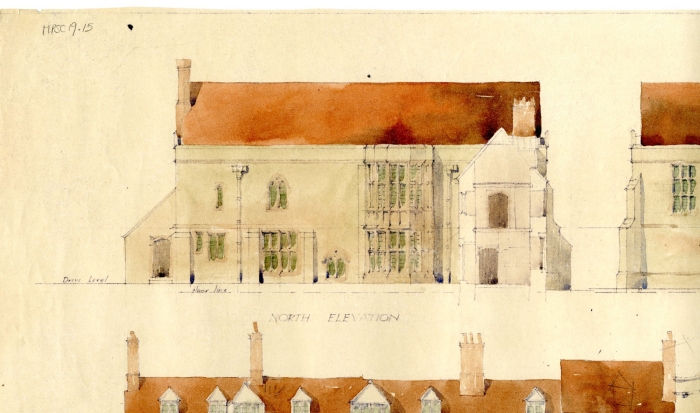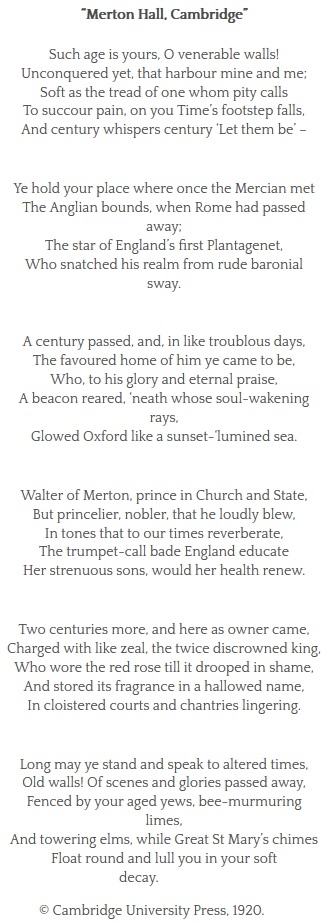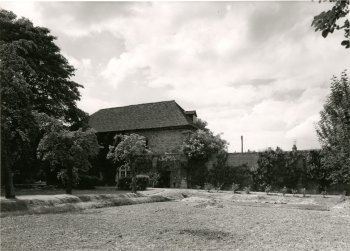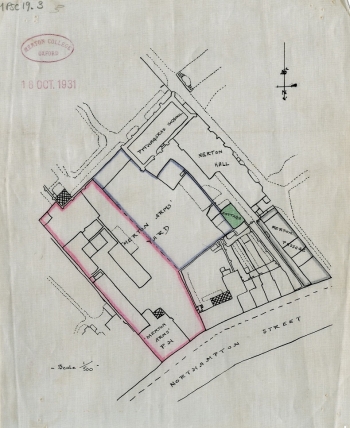Poetry, Plays and Pythag: Adapting the School in the Twentieth Century
Thomas Thornely
In the early twentieth century, Merton Hall was leased to the English poet and academic, Thomas Thornely (1855-1949). Thornely lived most of his life in Cambridge, having first studied at Trinity Hall during the 1870s, before becoming Fellow of Trinity Hall and University Lecturer in History, 1883-1907.
Even after his retirement from teaching in College, Thornely and his house remained familiar to students of Trinity Hall. In his foreword to Thornely’s book, Cambridge Memories (The Lighter Side of Long Ago), the writer J. B. Priestley - who came up to Cambridge in 1919 - recalls that Thornely
[…] was to be found in his beautiful old house, which made, as I still remember with delight, a perfect setting for chamber music. He must have been astonished, I realise now, by some of the young men he had to entertain in his drawing-room on musical evenings, bewildered and uncouth as some of us must have been, but he gave no sign, and was an admirable host.
Thornely writes affectionately of Cambridge in his poems and memoirs. The following poem, taken from the revised second edition of Verses from fen and fell (1920), offers a romantic vision of the School of Pythagoras and of Merton Hall:
Pythagoras and St. John’s
Ownership of the School of Pythagoras and of the surrounding area between Bin Brook and Northampton Street had rested with Merton College since the thirteenth century. In 1928, however, St. John’s College expressed an interest in entering into what would become a prolonged process of negotiation to secure possession of the Merton property. The initial response to this interest was negative. A second bid of £19,000 several years later in December 1933, this time proposed jointly by St. John’s College and Magdalene College, and £4,000 above the price at which the property had been valued by Messer J. Carter Jonas and Sons, was similarly declined.[1] Lord Victor Rothschild (1910-1990) and his family became tenants of Merton Hall and the interest of St. John’s College in the Merton property diminished for the time being.
In 1958-1959, negotiations with Merton College re-opened. By this point, Magdalene had lost interest in acquiring the Merton property and St. John’s College was able to make an independent offer. In April 1959, Merton College consented to accept:
an offer from St. John’s, if made, to buy the whole of the property adjoining Northampton Street and Queen’s Road for £80,000, each party paying its own costs and St. John’s paying the cost of an independent valuation, if the Ministry required one […] No restrictive covenants would be imposed. Merton would rely upon St. John’s intentions as to the future of the property.[2]
On the 24th April 1959, the St. John’s College Council approved the offer of £80,000 and on the 8th October 1959, the Deed of Purchase was sealed.[3]
The question now debated by members of St. John’s College was to what use the School of Pythagoras and Merton Hall could reasonably be put. Upon its acquisition by St. John’s in 1959, the School of Pythagoras was in a sorry state. As the Junior Bursar, Alec C. Crook, later reported:
The interior was as depressing as the exterior. The ground floor was broken up by partitions, one area providing lavatory accommodation, probably in connection with Lord Rothschild’s family kindergarten in a hut nearby. The upper floor carried a jumble of builder’s materials, and was appropriated by the maintenance staff as soon as the building was available to the College. The clunch was badly cracked, a general absence of pointing giving an atmosphere of ruin to a building which, if it had lacked its archaeological value as a rare first floor Hall, might well have been demolished without regret.[4]
The Master and Senior Bursar had come to a similar conclusion while inspecting the property in 1933, observing that “the School of Pythagoras [w]as of no practical use to the College” yet it would nevertheless be “vandalism to demolish the Hall to make room for anything more serviceable”.[5]
The New Buildings Committee was duly convened and in July 1963, a sub-committee submitted a report with recommendations for transforming the School of Pythagoras into a dramatic space. With the benefit of major renovation work, the upper floor of the School became a theatre with the capacity to seat an audience of 144 people. The School has subsequently served as a venue for numerous events, including conferences, poetry readings, film screenings and plays performed by the St. John’s performing arts society, the Lady Margaret Players.



